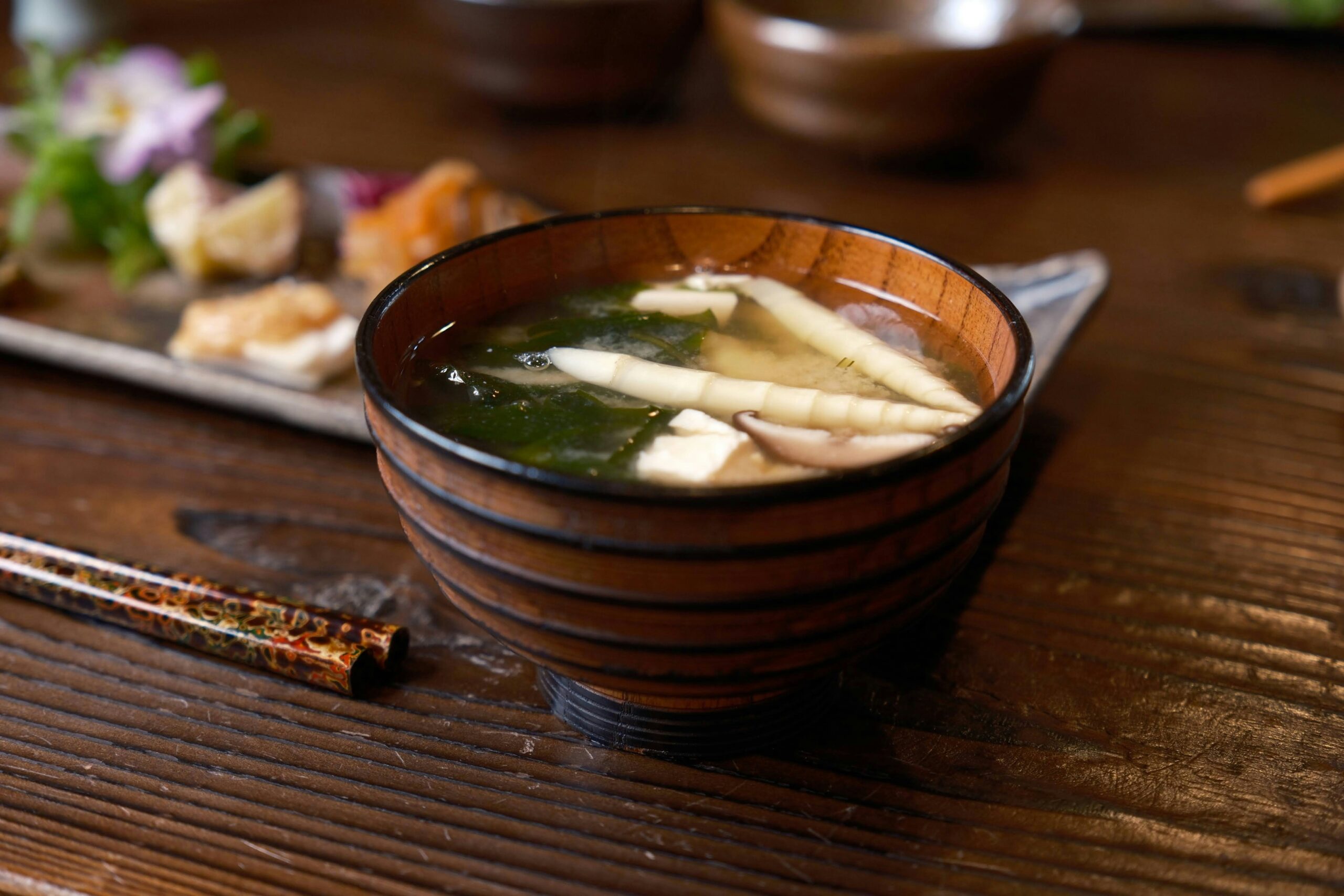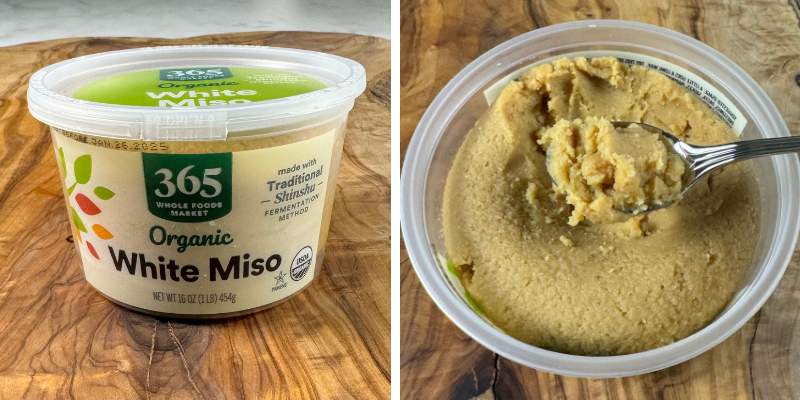As gut health continues to gain attention, experts and nutritionists point to miso and its merits as a fermented food. What exactly are the gut-boosting qualities of miso? How can we enjoy this superfood in creative and tasty ways?

A Primer on Miso: What Is It?
Miso is a traditional seasoning in Japanese cuisine that’s been around for centuries. Miso is made by fermenting soybeans with salt and a type of fungus called koji. Soybeans are first soaked in water and cooked until they are soft. They are then mixed with koji and salt and left to ferment for several months to several years, depending on the desired flavor and consistency.
During fermentation, the koji breaks down the starches in the soybeans into sugars, which are then further broken down into amino acids, giving miso its rich, savory flavor. After fermentation, the mixture is ground into a thick paste which we as consumers can find at the grocery store, typically in plastic tubs.

What Does Miso Taste Like?
Miso has a complex flavor profile that is often described as salty, savory, and slightly sweet. It can also have earthy, nutty, and umami undertones. “Umami” is often described as a savory or meaty taste that adds depth and richness to food.
Miso’s flavor is driven by factors such as the type of koji used, the fermentation process, and the length of aging. The taste of miso can range from mild and mellow to bold and intense, with different types of miso offering distinct flavor profiles.
Varieties of Miso Paste
Red Miso (‘aka-miso’) has a bold, intense flavor with deep umami notes and distinct saltiness. It undergoes a longer fermentation process (6 months to several years) and contains a higher proportion of soybeans to koji. The result is a stronger taste and darker color. Red miso paste can look dark reddish-brown to almost black.
Yellow Miso (‘shinshu miso’) has a balanced flavor profile that’s mildly sweet and subtle in its umami taste. It undergoes a shorter fermentation process (2-6 months) than red miso paste, resulting in a milder taste. Colorwise, yellow miso paste looks light yellow to golden brown.
White Miso (‘shiro miso’) has a more delicate, sweet flavor with mild umami notes. It goes through the shortest fermentation process (a few weeks to a few months), resulting in the mildest taste of the three types. “White” is somewhat of a misnomer, as white miso paste has a pale yellow to light beige color.

Miso and Gut Health
Miso is amongst a coveted group of fermented foods that have attracted considerable scientific interest for their health benefits. The probiotics in miso promote a healthy balance of gut microbiota, which is essential for optimal digestion, immune function, and overall well-being. When consumed regularly, miso contributes to:
- Increased Microbial Diversity: Consumption of miso has been associated with an increase in the diversity of gut bacteria, which is generally considered a sign of a healthy gut microbiome. Miso contains live beneficial bacteria, such as various strains of Lactobacillus and Bifidobacterium, which can colonize the gut and promote microbial diversity.
- Beneficial Gut Bacteria: Miso has prebiotic fibers, such as oligosaccharides, that serve as food for beneficial bacteria in the gut. In addition, the probiotics in miso help restore and maintain a diverse and balanced population of beneficial bacteria in the gut, which is crucial for proper digestion and nutrient absorption.
- Reduction of Harmful Bacteria: Some studies suggest that the probiotics found in miso may also have antimicrobial properties, helping to reduce the growth of harmful bacteria in the gut.
- Healthy Digestive Function: The probiotics found in miso can aid in the breakdown of food, improve digestion, and alleviate common digestive issues such as bloating, gas, and constipation. Eating miso provides active enzymes that help your body digest and absorb important nutrients. Its plant fibers also help keep your intestines clean.
- Stronger Immune Function: A significant portion of the body’s immune system resides in the gut. Miso’s probiotics contribute to a healthy gut microbiome which can help reduce the risk of infections and inflammatory conditions.
- Reduced Inflammation: Fermented foods like miso contain bioactive compounds and antioxidants that can help reduce inflammation in the gut and throughout the body, contributing to overall gut health and well-being.
Nutritional Profile of Miso
In addition to its probiotic content, miso is also rich in various vitamins and minerals, including B vitamins (such as B12), vitamin K, manganese, and zinc. These nutrients play important roles in energy metabolism, bone health, blood clotting, and immune function.
Fermented foods like miso contain antioxidants, which help protect the body against oxidative stress and inflammation. Antioxidants may reduce the risk of chronic diseases such as heart disease, cancer, and neurodegenerative disorders.
Miso contains a moderate amount of protein and is relatively low in fat and calories, making it a nutritious addition to meals without contributing excess calories or unhealthy fats.
Above: Oven-baked Miso Chicken
Where Can I Buy Miso Paste?
In the U.S., you can buy miso paste at various places including:
Grocery Stores: Many large supermarkets, such as Whole Foods, Kroger, and Safeway, often carry miso paste in the international or Asian foods section.
Asian Markets: Specialty Asian grocery stores typically have a wider selection of miso paste.
Health Food Stores: Stores like Trader Joe’s and Sprouts often stock miso paste in the refrigerated section.
Online Retailers: Websites like Amazon, Walmart, and specialty sites like Asian Food Grocer and Thrive Market offer a variety of miso paste options.
When shopping at a grocer, look for miso in the refrigerated section alongside tofu and other fermented products.
Ways to Incorporate Miso in Your Diet
There are many delicious ways to incorporate miso into your diet. Here are some ideas:
- Miso Soup: The classic way to enjoy miso is in miso soup. Simply dissolve miso paste into hot water or broth, then add ingredients like tofu, seaweed, green onions, and vegetables for a nourishing and flavorful soup.
- Miso Dressings and Sauces: Use miso paste as a base for salad dressings, marinades, and sauces. Combine miso paste with a neutral oil, vinegar, soy sauce, ginger, and garlic to create flavorful dressings for salads or dipping sauces for vegetables, meats, and tofu. Add this flavor-packed Sesame Miso Dressing to your regular rotation of salad dressings.
- Miso Glazes: Create a sweet and savory miso glaze for tofu, fish, or chicken. Mix miso paste with ingredients like honey, soy sauce, sesame oil, and ginger and glaze your protein before cooking. Miso glaze is the magic in our Oven Baked Miso Chicken and Air Fryer Miso Cod.
- Miso Stir-Fry: Use miso paste as a flavoring agent in stir-fry dishes. Add miso to the stir-fry sauce along with soy sauce, garlic, ginger, and other seasonings for a quick and flavorful meal with plenty of umami.
- Miso Noodles: Use miso paste in a savory sauce for noodles. Try these Miso Soba Noodles, which features buckwheat noodles and julienned vegetables tossed in a delicious miso garlic sesame sauce.
- Miso Veggies: Add a rich, umami flavor to turn ordinary vegetables into extraordinary. Try this Sesame Miso Spinach as a appetizer, side, or on top of poke bowls.
- Miso Butter: Blend miso paste with softened butter to create a rich and flavorful spread for bread, crackers, or cooked vegetables. Miso butter adds depth of flavor to dishes and is especially delicious when spread on roasted sweet potatoes or corn on the cob.
- Miso Mayo: Mix miso paste into mayonnaise to create a tangy and umami-rich spread for sandwiches, wraps, and burgers. Miso mayo adds a unique flavor twist to classic condiments and pairs well with grilled meats, seafood, and vegetables.
- Miso Hummus: Add miso paste to homemade hummus for an extra layer of flavor and complexity. Miso hummus is delicious as a dip for raw vegetables, crackers, or pita bread, or as a spread for sandwiches and wraps.
We published a round-up of 10 great miso recipes here, from Gut Haven and other food blogs.
Above: Miso Sesame Dressing
Potential Drawbacks of Miso
While miso offers numerous health benefits, there are a few potential drawbacks to consider:
High Sodium Content: Miso is often high in sodium. And we know that high sodium intake can contribute to high blood pressure and other cardiovascular issues. However, recent research suggests that miso can in fact decrease blood pressure and sympathetic activity via the inhibition of ACE (angiotensin converting enzyme) activity.
Allergies and Sensitivities: Some individuals may have allergies or sensitivities to soy, which is a common ingredient in miso. Additionally, miso may contain gluten if it is made with barley or wheat, which can be problematic for those with gluten intolerance or celiac disease.
Interactions with Medications: Some sources suggest that fermented soy products like miso can interact with certain medications or interfere with their absorption, so it’s important to consult with a healthcare professional if you have concerns about potential interactions.





